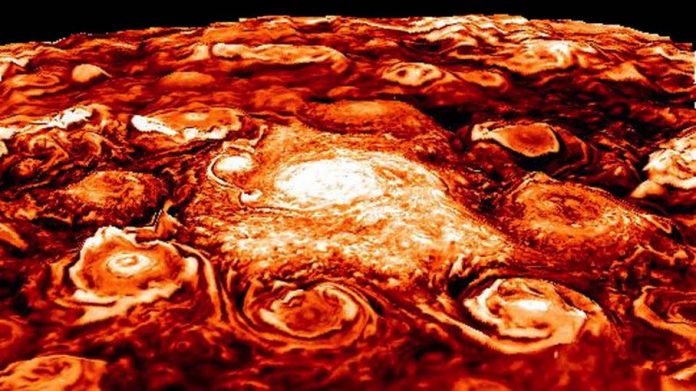Researchers studying Jupiter using data and observations from the Juno spacecraft just released four new papers on their results, and I honestly can’t say what’s cooler: the science, or the jaw-dropping images.
The swirling, massive storms raging across Jupiter’s north and south poles are unlike anything else ever encountered in our solar system, NASA researchers announced earlier this week. The agency provided that statement, along with some stunning new imagery of the planet, as part of a treasure trove of new findings gathered by the Juno spacecraft.
“Prior to Juno, we did not know what the weather was like near Jupiter’s poles. Now, we have been able to observe the polar weather up-close every two months,” Alberto Adriani, Juno co-investigator from the Institute for Space Astrophysics and Planetology, Rome, said in a statement. “Each one of the northern cyclones is almost as wide as the distance between Naples, Italy and New York City — and the southern ones are even larger than that. They have very violent winds, reaching, in some cases, speeds as great as 220 mph (350 kph). Finally, and perhaps most remarkably, they are very close together and enduring. There is nothing else like it that we know of in the solar system.”
Jupiter’s north pole (shown above) features one cyclone surrounded by eight similarly sized cyclones with diameters for all averaging between 2,500 to 2,900 miles. The dark areas represent temperatures of around minus 181 degrees Fahrenheit (minus 188 C), while the lighter areas are as warm as 9 degrees Fahrenheit (minus 12 C). Its south pole, shown below during an earlier flyby, includes a single cyclone surrounded by five swirling counterparts with diameters for all ranging between 3,500 to 4,300 miles.
One big riddle raised by this unprecedented study of Jupiter’s poles is why the cyclones continue to rage as separate entities.
“The question is, why do they not merge?” added Adriani. “We know with Cassini data that Saturn has a single cyclonic vortex at each pole. We are beginning to realize that not all gas giants are created equal.”
You can see an up-close view of some of the other colorful, swirling storms in the composite flyby captured by Juno at its perijove, or the point in its orbit nearest to the planet’s center, in the gorgeous video below.
In addition to the cyclones, NASA also revealed that Juno’s advanced instruments have been able for the first time to peer deep into Jupiter’s interior. They discovered that the gas giant’s colorful bands, spurred by intense winds, extend some 1,900 miles beneath the surface. They’re also quite dense, containing some 1 percent of the planet’s total mass.
“By contrast, Earth’s atmosphere is less than 1 millionth of the total mass of Earth,” Yohai Kaspi, Juno co-investigator from the Weizmann Institute of Science, Rehovot, Israel, and lead author. “The fact that Jupiter has such a massive region rotating in separate east-west bands is definitely a surprise.”
The other surprise? Juno detected that underneath its colorful, violent shroud, the planet rotates nearly as a rigid body.
“This is really an amazing result, and future measurements by Juno will help us understand how the transition works between the weather layer and the rigid body below,” said Tristan Guillot, a Juno co-investigator from the Université Côte d’Azur, Nice, France. “Juno’s discovery has implications for other worlds in our solar system and beyond.”
These discoveries and others are detailed in a series of papers published this month in the journal Nature.
As for Juno, NASA currently has plans to continue using the spacecraft to reveal more of Jupiter’s secrets through at least July 2018. Should the mission not be extended, Juno will perform a controlled deorbit and disintegrate into the planet’s atmosphere to prevent contamination of any nearby moons that might possibly harbor life.















